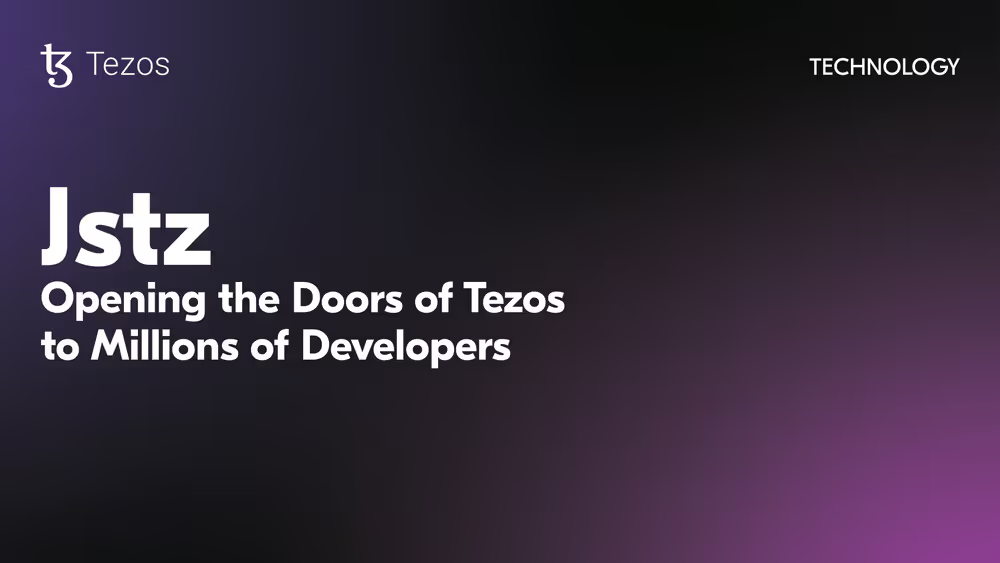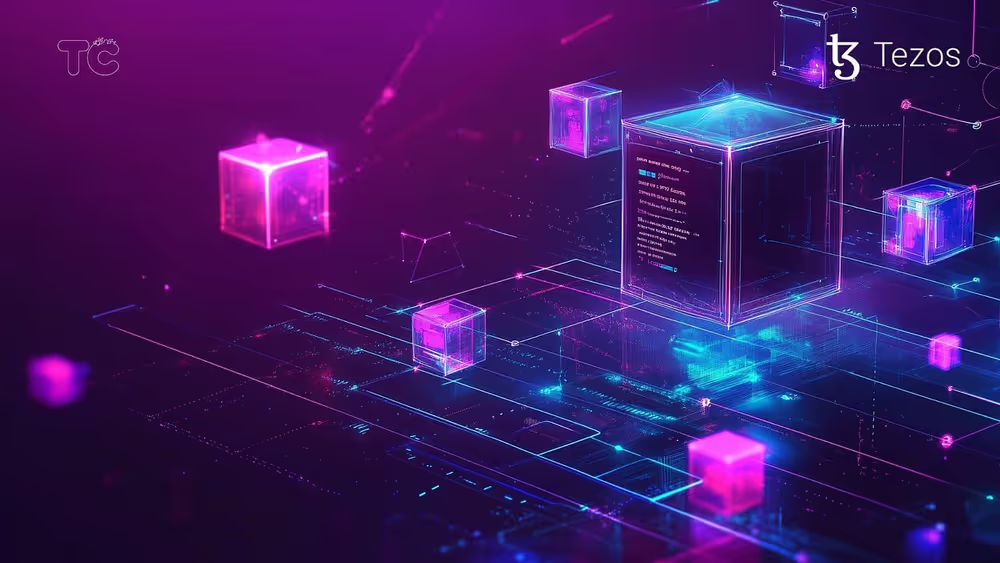Jstz: Opening the Doors of Tezos to Millions of Developers
Build on Tezos using the language you already know - full JavaScript, no compromises.
7 minute read

One of the most frustrating things in crypto is watching great tech struggle to reach the people who could actually build with it. Tezos has been quietly shipping some of the most advanced features in the space, self-amendment, on-chain governance, smart rollups, and formal verification, but for many developers, it still felt like something you needed to study before you could start. That’s where Jstz comes in.
This is Tezos taking a very practical step: meeting developers where they already are. Instead of expecting people to learn an entirely new stack, Jstz offers a way to build directly on Tezos using JavaScript, the language most developers already know. And not a limited subset or some watered-down version, actual, full JavaScript.
In this article, I’ll walk you through why Jstz matters, what problems it solves, and how it fits into the bigger picture for Tezos. I’ve also reached out to Beata Lipska, Head of Developer Relations at Trilitech, to get some direct insights from someone closely involved in the project. You’ll see her thoughts sprinkled throughout.
The real problem Jstz is solving #

Let’s be honest: most blockchains make you learn their way of doing things. Ethereum has Solidity, Solana has Rust, Tezos has Michelson. These languages serve specific purposes, especially when you care about security and formal verification, but they also create a huge barrier.
Most of the world’s developers aren’t blockchain experts. They’re web developers, backend engineers, and mobile app builders. They know JavaScript. There are over 20 million JavaScript developers out there, but very few of them are writing smart contracts today.
Jstz is Tezos extending a hand to that huge group: “Hey, you don’t need to change everything you know. Bring your skills as they are — and build on Tezos.”
Full JavaScript — not “JavaScript-ish” #
Now, a lot of projects have tried to bring JavaScript to crypto before. But most of the time, it’s been compromised: subsets, transpilers, custom VMs that only kind of speak JavaScript.
Jstz is different. This is full JavaScript. Node.js, Deno, TypeScript, NPM, all supported out of the box. You don’t have to learn a new workflow. If you can write a Node app, you can write Jstz code. You can use your existing libraries, your existing tools, and just start building.
We didn’t want Jstz to feel like another half-solution. If we ask JavaScript developers to try blockchain, the least we can do is speak their language — fully. That’s why Jstz supports Node, NPM, and the entire toolchain out of the box. It’s not a ‘blockchain version of JavaScript.’ It’s JavaScript, period.
— Beata Lipska
This is one of the most important design choices Jstz makes. It’s not asking developers to adapt. It adapts to the developers.

Running on Smart Rollups: Why Architecture Matters #
Jstz lives on top of Tezos Smart Rollups, the Layer 2 scaling solution that’s becoming one of Tezos’ strongest technical pillars. With Smart Rollups, you can spin up specialized execution environments secured by Tezos Layer 1, but with far more flexibility and scale.
Etherlink is one example, an EVM-compatible rollup. Jstz is another, purpose-built for JavaScript.
What makes this approach powerful is that it doesn’t force Tezos into one mold. Different rollups can serve different communities, while still anchoring into Tezos’ core security and governance. As Tezos X continues to roll out, we’re moving closer to true interoperability between different VMs, allowing all these environments to eventually talk to each other, securely and natively, across the entire Tezos ecosystem.
Smart Rollups give us a powerful foundation. They let us build purpose-specific environments like Jstz, while still anchoring into Tezos’ security model. Our goal is to make Jstz a fully RISC-V environment with a native JavaScript runtime — so you can use NPM, your favorite libraries, and all the familiar tooling from the JS ecosystem. For developers, it means the freedom to build with speed and flexibility, without needing to touch Layer 1 complexity.
— Beata Lipska

Lowering the barrier — with a few bonus side effects #
The real value of Jstz is that it allows developers to start experimenting right away, using tools they already know. Instead of having to first learn blockchain-specific languages or smart contract paradigms, they can prototype quickly in JavaScript, whether for dApps, business logic, or backend services that interact with on-chain data.
And while the main goal is accessibility, there’s also a side benefit here: AI-powered coding tools (like Copilot, GPT-4, Claude, etc.) happen to be very good at writing JavaScript, simply because the training data for JavaScript is enormous. This makes it even easier for newer developers to get up to speed, experiment, and iterate faster when building with Jstz.
“One of the most exciting moments was watching a JavaScript developer build something on Jstz within their first hour. They didn’t ask about Tezos, consensus, or gas — they just started coding. I felt it myself while preparing the TezDev 2024 demo: I had everything up and running in just a few hours, with help from an LLM. That’s the power of familiar tools — it lowers the barrier so real creativity can kick in.”
— Beata Lipska

Security: options, not trade-offs #
One of the reasons blockchains invented custom languages was to handle security. Michelson, for example, was built with formal verification in mind, allowing developers to mathematically prove their code works as intended.
Jstz doesn’t offer that same level of strictness out of the box. But not every application needs formal proofs. Most of what developers want to build, marketplaces, web apps, services, doesn’t involve the same risk level as core financial infrastructure.
The key is that Tezos will now offer both (and more). Do you want extreme guarantees? Use Michelson. You want fast iteration and flexibility? Use Jstz. They don’t compete, they complement each other.
A quiet but important shift for Tezos #
If you step back, Jstz is part of a broader evolution happening on Tezos right now. The ecosystem is expanding to meet developers where they are, instead of making them fit into a single model. Between Michelson, Etherlink, and now Jstz, Tezos is covering multiple developer profiles while still keeping its core values intact.
Innovation, for us, means staying true to Tezos’ core values — like decentralization — without compromise. But it also means evolving. With Jstz, we’re opening the doors to industry-leading languages and welcoming developer communities who could benefit from adding blockchain to their stack, without first climbing a steep learning curve. It’s about keeping what matters, and removing what gets in the way.
— Beata Lipska
This isn’t about hype cycles or chasing whatever’s trendy this month. It’s about making sure that when real builders come knocking, Tezos has the tools ready for them, no matter where they’re coming from.

The bottom line — and a simple first step #
Jstz might not grab headlines in the same way a flashy DeFi launch or a viral NFT drop would. But in terms of long-term impact, it’s one of the smartest moves Tezos has made. It opens doors, lowers barriers, and gives millions of developers a way in.
And here’s the best part: you don’t have to wait. If you’re a JavaScript developer curious about building on Tezos, you can try out the Jstz sandbox right now. It’s live, it’s simple to start, and the team is actively looking for developer feedback to help refine it further.
Sometimes it’s the quiet, practical upgrades that do the most work. Jstz is exactly that kind of upgrade.